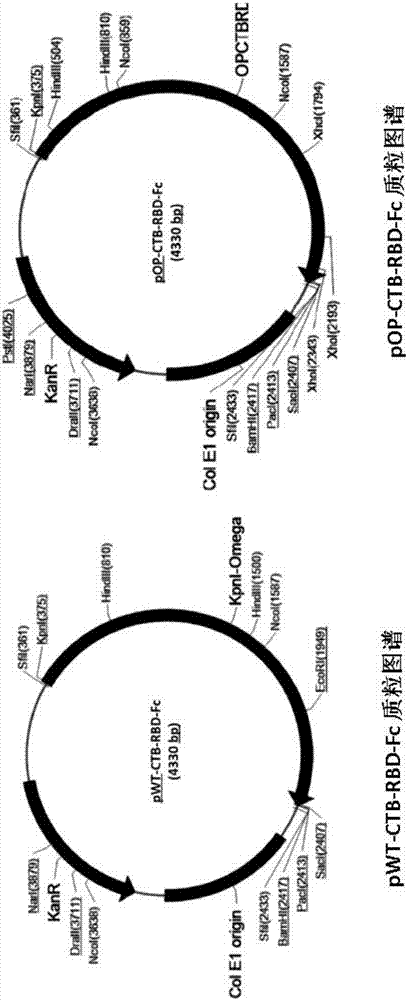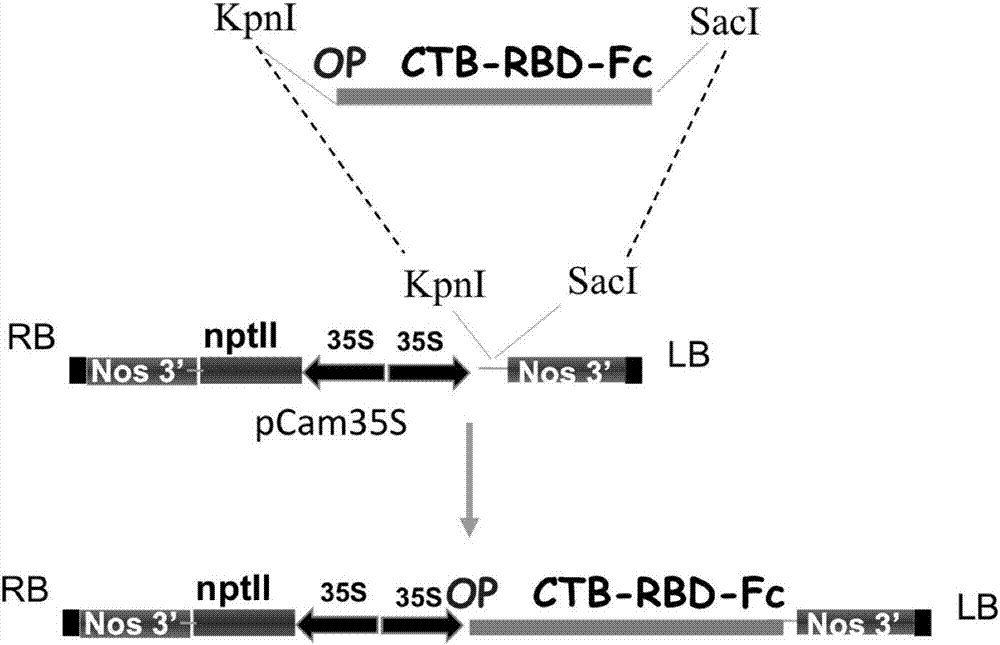Application of plant as host in expressing vaccine of Middle East Respiratory Syndrome
A technology for respiratory syndrome and plants, applied in the direction of vaccines, medical preparations containing active ingredients, microorganisms, etc., can solve the problems of high price, low production capacity of animal cells, and low safety, and shorten the production cycle and production cost , reduce biosafety issues, and facilitate the effect of protein purification
- Summary
- Abstract
- Description
- Claims
- Application Information
AI Technical Summary
Problems solved by technology
Method used
Image
Examples
Embodiment 1
[0050] The construction of embodiment 1 plant transient expression vector
[0051] In order to improve the expression and translation of the protein in the lettuce system, the present invention redesigned CTB-S377-588-Fc to preferentially match the codon frequency found in plants (the sequence is shown in SEQ ID No.7). Cholera toxin B subunit (CTB) can be shown to increase antigen uptake and potently induce mucosal responses. To improve the immunogenicity of intranasal vaccine, we fused CTB (Genbank ID: AY475128.1) to RBD (Genbank ID: KM027288.1)-Fc (Genbank ID: BC156864.1). CTB-S377-588-Fc optimized codon will base by GeneArt TM GeneOptimizer TM (ThermoFisher) designed and synthesized.
[0052]Add Kpnl restriction site at the 5' end of CTB-S377-588-Fc and optimized sequence, add Sacl and Pacl sites at the 3' end, and generate pWT-CTB-RBD-Fc and pOP-CTB- by ThermoFisher RBD-Fc vector. The gene fragments were isolated by Kpnl / Sacl, and cloned into the binary plant expressi...
Embodiment 2
[0054] Example 2 Agrobacterium-mediated vacuum infiltration
[0055] The prepared Agrobacterium culture suspension was placed in a 2L beaker and placed in a desiccator. The first 10% of the lettuce was removed with a knife, turned upside down (core up) and gently swirled in the bacterial suspension, the desiccator was sealed. The vacuum pump (Welch Vacuum, Niles, IL, USA) was turned on to evacuate for approximately 25-45 s until bubble formation on the leaf space was observed. And it can be seen that the permeate is in the leaf tissue. Maintain the pressure state for 30-60 seconds. The pressure is quickly released to allow the penetrant to seep into the spaces within the tissue. This process was repeated 2 to 3 times until the penetration of the permeate into the lettuce tissue was clearly visible. The lettuce tissue was then gently removed from the permeate and rinsed three times consecutively with distilled water before being transferred to a container covered with plast...
Embodiment 3
[0056] Example 3 Protein Extraction and Separation
[0057] Lettuce samples subjected to vacuum infiltration by Agrobacterium were stirred with a stirrer, and homogenized at high speed in a blender for 1 to 2 minutes with an extraction buffer (100 mM KPi, pH 7.8; 5 mM EDTA; 10 mM β-mercaptoethanol) with a volume ratio of 1:1. The homogenate was adjusted to pH 8.0, filtered through gauze, and the filtrate was centrifuged at 10,000 g for 15 min at 4°C to remove cell debris. The supernatant was collected, mixed with ammonium sulfate (50%), and incubated with shaking on ice for 60 min. Centrifuge again (10,000 g) for 15 min at 4°C. The obtained supernatant was subjected to a second round of ammonium sulfate (70%) precipitation, shaken and suspended on ice for 60 min, and centrifuged again at 10,000 g for 15 min at 4°C. Then, the supernatant was discarded, and the protein precipitated from the treated sample was dissolved in 5 mL of buffer (20 mM KPi, pH 7.8; 2 mM EDTA; 10 mM β-m...
PUM
 Login to View More
Login to View More Abstract
Description
Claims
Application Information
 Login to View More
Login to View More - R&D
- Intellectual Property
- Life Sciences
- Materials
- Tech Scout
- Unparalleled Data Quality
- Higher Quality Content
- 60% Fewer Hallucinations
Browse by: Latest US Patents, China's latest patents, Technical Efficacy Thesaurus, Application Domain, Technology Topic, Popular Technical Reports.
© 2025 PatSnap. All rights reserved.Legal|Privacy policy|Modern Slavery Act Transparency Statement|Sitemap|About US| Contact US: help@patsnap.com



